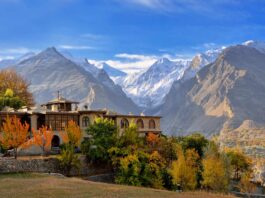
The Hunza Valley, located in the northernmost region of Pakistan, is widely known for its breathtaking landscapes, including towering peaks, lush green valleys, and crystal-clear lakes. However, what makes this region even more alluring is the stunning display of nature’s beauty during the cherry and apricot blossom season.
Every year, from mid-March to early April, the Hunza Valley is blanketed with a riot of colors, as the cherry and apricot trees burst into bloom. The valley becomes a paradise of white and pink hues, and the sweet fragrance of the blossoms fills the air, leaving visitors spellbound.
The Hunza cherry and apricot blossom season is a time of celebration and joy for the locals, who have been cultivating these fruits for centuries. These trees have become an integral part of the region’s culture, and the blossoms are a symbol of hope and prosperity for the new year.
The Hunza cherry trees, also known as Prunus serrulata, are a species of ornamental cherry tree that is native to Japan, but have been widely cultivated in other parts of the world, including the Hunza Valley. These trees have an average height of 20-40 feet and produce beautiful, delicate, pink or white flowers that bloom in clusters.
The apricot trees, on the other hand, are native to China but have been cultivated in the Hunza Valley for centuries. Apricot trees have an average height of 20-30 feet and produce fragrant white or pink flowers that bloom before the leaves appear.
The Hunza Valley is home to some of the oldest apricot trees in the world, with some trees being over 900 years old. These trees have been carefully preserved and nurtured by the locals, who consider them a precious asset of their cultural heritage.
Apart from their aesthetic value, the Hunza cherry and apricot trees are also an essential source of livelihood for the locals. The fruits of these trees are harvested in summer and fall and are used to make jams, jellies, pickles, and other local delicacies. These fruits are also exported to other parts of the country and are a significant source of income for the locals.
The Hunza Valley is also home to some of the most unique and diverse flora and fauna in the world. The region’s unique topography and climate have given rise to several endemic species of plants and animals that are found nowhere else in the world.
The cherry and apricot blossom season is an excellent time for visitors to explore the region’s natural beauty and wildlife. The valley is home to several species of birds, including the golden eagle, lammergeier, and Himalayan snowcock. The region’s rivers and lakes are also teeming with fish, including the trout and the Himalayan snow trout.

Visitors to the Hunza Valley during the cherry and apricot blossom season can enjoy several outdoor activities, including trekking, mountaineering, fishing, and camping. The valley’s rugged terrain and pristine natural beauty provide an excellent opportunity for adventure enthusiasts to explore the region’s hidden treasures.
The Hunza Valley is also known for its rich cultural heritage, and visitors can experience the region’s unique customs and traditions during the cherry and apricot blossom season. The locals organize several cultural festivals and events during this time, where visitors can witness the region’s vibrant music, dance, and cuisine.
In conclusion, the Hunza cherry and apricot blossom season is a spectacular display of nature’s beauty that should not be missed. The valley’s stunning landscapes, diverse wildlife, and rich cultural heritage make it an ideal destination for nature lovers and adventure enthusiasts. The cherry and apricot trees have become an integral part of the region’s culture



